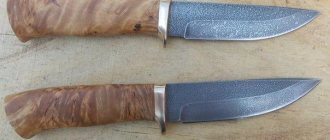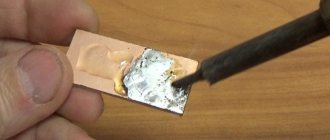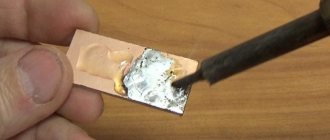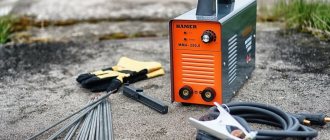In this article I will tell you how to make a forge that runs on propane.
A homemade blacksmith's forge can be used for forging knives, swords, working with glass, or any other work that requires heating something to a very high temperature.
Some parts of the mini forge are welded with a welding machine, but if you do not have welding skills, be smart - you can bolt the structure together or solder it.
Warning! Do not start making a forge at home using propane fuel if you do not have experience working with propane. Although propane is not dangerous when used correctly, there are still dangers. The burner is large and an explosion can damage your property and harm your health. I warned you and I do not bear responsibility for your further actions.
Always wear protective equipment when lighting and operating the burner. The minimum you should wear is safety glasses or a face mask, cotton or leather protective gloves. Do not wear clothes made of synthetic materials if you are going to work with a burner, as they will quickly flare up.
Principle of operation
The principle of operation of the forge is based on the chemical reaction of combustion of carbon, which, when reacting with oxygen, forms carbon dioxide with the release of heat. In addition, metal recovery occurs, which is a very important aspect for the formation of homogeneous, high-strength parts.
To maintain an optimal level of combustion and temperature, air ducts and air chambers are installed inside the fuel chamber, which forcefully pump pure oxygen. Due to this, it is possible to obtain temperatures above +1000°C, which are unattainable with conventional combustion of solid fuel (coal or wood).
At the same time, using the inflation technology, the volume of air is selected so that there is always a slight lack of oxygen for the oxidation reaction to occur. In other words, it is necessary to select an operating mode to prevent metal combustion.
The time the smelted part remains in the furnace should also be limited, since in an atmosphere of carbon dioxide the metal will begin to react with it and form a high-strength alloy with increased fragility. These negative consequences can be avoided by introducing additional oxygen into the chamber in such an amount that carbon dioxide has time to completely react.
Conclusions and useful video on the topic
The injection burner developed by Alexander Kuznetsov is especially popular. In this video, he explains what the structure consists of and how to assemble it:
Example of an injection burner operation:
Properly designed and made with your own hands exactly according to the requirements, the injection burner will become a reliable assistant for a long time. This device will replace expensive factory-made tools. With its help, you can solve many everyday problems without resorting to the help of professionals.
Would you like to tell us about how you assembled an injection torch for blacksmithing with your own hands? Do you have useful information on the topic of the article? Please leave comments in the block form below, ask questions, post photographs.
Custom design
Stationary models of the forge should be made taking into account the anthropometric data of the master. This is necessary to ensure maximum comfort during forging, because a red-hot piece of iron weighing several kilograms poses a serious danger to both the master and those around him. The most important thing in the process of work is to ensure maximum safety and comfort.
To correctly determine the size of the workplace, the help of a second person is necessary. So, the height is measured from the floor to the elbow of the master, whose arm is in a relaxed position and whose legs are shoulder-width apart. To the resulting figure you need to add another 5 cm, which will become the optimal height for the workplace.
The shape of the table is best square for the work of one master; for work with an assistant, you can make it rectangular. In the case of a square shape, the length of the side is determined by determining the diagonal. To do this, the assistant needs to measure the length from the master's abdomen to the end of the largest pliers in an outstretched hand. Another 10 cm is added to the resulting number and half the diagonal is obtained. Next, if you wish, you can simply multiply the result by 1.414 or determine the length of the entire diagonal and solve the equation from the school curriculum C2 = a2 + a2, where C is the resulting diagonal, and is the side of the table.
Burner classification
The essence of the operation of gas burners is to ensure stable and continuous combustion of fuel in the combustion chamber of the boiler. Equipment classification is based on the four main functions of the device, such as:
- supply of gas and air in proportions that provide the optimal ratio in the mixture;
- direct mixing of gas and oxygen;
- creating stable combustion;
- ensuring uniform combustion and avoiding explosion when ignited.
Modulated equipment is included in a separate class. A distinctive feature of such devices is the ability to automatically adjust to the current needs of the room and the ability to change the combustion power depending on the temperature conditions inside and outside the building. Due to such capabilities, this type of equipment is characterized by increased efficiency.
Firebox rules
The optimal fuel is fine coke, which, although more expensive than regular coal, is consumed in minimal quantities for work. Since high temperature is required to ignite it, a homemade forge for a forge must first be heated with wood. Only after the main fuel has burned out is the preparation introduced into the hearth for ripening, reducing the blast.
In order for the forge to work correctly on ordinary coal, it must first be fried to completely evaporate the coke oven gas, which will become clear by the change in color of the flame. Such fuel is usually used for the manufacture of large original products.
To forge figures from Damascus at home, it is necessary to use charcoal for the firebox, but this fuel requires jewelry work, since it instantly responds to blowing and quickly burns out.
You can also use ordinary hardwood firewood for the firebox, but first burn it in the shell to completely prevent unburned wood chips from getting on the metal. This method of producing heat is considered the most economical.
Forge
Creative people involved in decorative work often show a desire to use handmade metal parts in their decorations. You can make such elements in a forge if you have the necessary skills and materials.
Quite thin sheet metal can be minted, bent, and attempted to be stamped even without heating. However, thick workpieces can only be processed at high temperatures. And only master blacksmiths can make something from carbon steel.
If you have a fireplace in the workshop, as well as an anvil, you can not pay attention to the thickness of the workpiece. When heated to a thousand degrees, such a metal will bend, flatten and forge like plasticine. The most important thing in this work is a properly constructed forge that can heat the metal to the required temperature.
Not everyone will be able to make such a forge with their own hands, but for a person familiar with the structure and operating principle of this device, this should not be difficult. Experienced blacksmiths claim that the simplest forge can be made from 6 bricks.
Principle of operation
The principle of operation of the forge is based on the chemical reaction of combustion of carbon, which, when reacting with oxygen, forms carbon dioxide with the release of heat. In addition, metal recovery occurs, which is a very important aspect for the formation of homogeneous, high-strength parts.
To maintain an optimal level of combustion and temperature, air ducts and air chambers are installed inside the fuel chamber, which forcefully pump pure oxygen. Due to this, it is possible to obtain temperatures above +1000°C, which are unattainable with conventional combustion of solid fuel (coal or wood).
What does a DIY gas forge look like?
At the same time, using the inflation technology, the volume of air is selected so that there is always a slight lack of oxygen for the oxidation reaction to occur. In other words, it is necessary to select an operating mode to prevent metal combustion.
The time the smelted part remains in the furnace should also be limited, since in an atmosphere of carbon dioxide the metal will begin to react with it and form a high-strength alloy with increased fragility. These negative consequences can be avoided by introducing additional oxygen into the chamber in such an amount that carbon dioxide has time to completely react.
How the device works
Before you build a forge, you need to decide on its type. The closed-type forge has a chamber for heating the workpiece. This model is considered the most economical in terms of fuel consumption. But in this case, the blanks are limited in size.
In an open-type forge, fuel is poured from above onto the grate, and an air flow is supplied from below. The heated workpiece is placed on the fuel. This makes it possible to heat large-sized workpieces.
In order to be able to build a homemade forge without losing its quality of work and at the same time saving money, you should understand the principle of its operation. The device is based on a significant increase in temperature due to the chemical method of carbon combustion.
This process gives a high energy yield and has been used for many centuries to smelt various metals. To prevent the cupola from allowing the material to burn, you should supply it with slightly less oxygen than is needed for complete oxidation, otherwise the products will be too fragile and, accordingly, will last only a few years.
Useful tips
- Cutting a small hole in the back of the forge will improve ventilation. In addition, this cutout allows you to heat long metal workpieces.
- The forge is placed on a special metal stand or table, which makes working with it more convenient. The height is selected individually by the master.
- If a forge shop works with workpieces of different sizes and shapes, then it is advisable to install several forges of different dimensions at once. They are placed close to each other, and gas and air are supplied using flexible hoses. This design solution allows you to quickly reconnect the burners.
- Each gas pipeline must have a shut-off valve. For this purpose, conventional valves are most often used - they provide smoother adjustment, unlike ball analogues.
The main thing in creating a forge with your own hands is to understand the principle of operation, select the right materials and follow safety precautions. Such equipment is created by craftsmen based on personal preferences, wishes and requirements, which provides wide scope for activity.
Main parts
The mechanism of operation of the forge is quite simple. The design of the forge resembles an oven with three partitions and one open side. Its main function is to maintain the highest possible temperature inside.
The design of a self-assembled forge differs little from production equipment.
The classic design should have:
- fireproof table;
- hearth with grate;
- device camera;
- umbrella;
- air chamber, valve and drainage;
- chimney;
- hardening bath;
- hole for feeding workpieces;
- air duct for oxygen supply;
- gas-air chamber;
- the furnace is removable.











